Director’s Notebook:
Before I interviewed Professor Shu-Yii Wu, I had a chance to chat with his secretary for a bit. Through our conversation, I could feel her admiration for her boss. “Professor Wu works super hard to connect with the world. I feel like I’ve learned a lot because of his nuanced international perspective that he has gained from having worked abroad.” During our interview, Professor Wu passionately said, “I feel that throughout our journey we have worked step by step to have our ideas take root.” This heartfelt statement underscores the dedication that Professor Wu has spent creating the APEC Research Center for Advanced Biohydrogen Technology (APEC-ACABT) over the past 18 years. Professor Wu’s quote “Join us to join the world” is more than just an empty slogan. It reflects the admiration Professor Wu has garnered from world-class public, private, academic, and research institutions from all over the world.
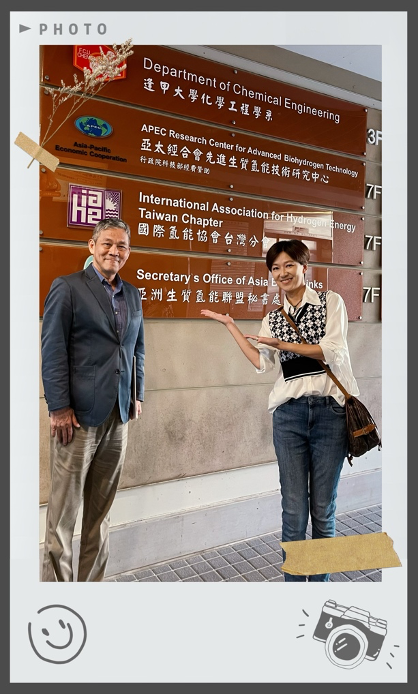
Picture 1: Professor Shu-Yii Wu introducing the story of bringing a world-class research center to Feng Chia University (Photo taken by Pei-lin Lin)
ACABT Feng Chia Hydrogen Energy Team – Bioenergy’s Top Performer
The first thing I noticed when going into Feng Chia University’s Science and Aeronautical Engineering Building was three prominent signs that said: “APEC Research Center for Advanced Biohydrogen Technology” “International Association for Hydrogen Energy Taiwan Chapter,” and “Asia BioHyLinks,” (which was formally changed to World BioHyLinks in 2023). Even though it seemed like I was just in a university, I’d stepped into a world-class research institution. Thus, I couldn’t help but ask Professor Wu how Feng Chia University could get such a prestigious research center housed on its campus. Professor Wu replied, “Within the various countries of APEC, there are 21 research centers. We are just one of them. However, since we have already completed three APEC projects, we believe that there isn’t anyone like us in Taiwan. Moreover, this year we are carrying out our fourth PPSTI 205 2023A: Green Synergy Solutions to Net-Zero Emissions Based on Bioenergy Technologies for Resilience and Sustainability. We only got APEC project funding recently because in the past applying for APEC project funding was difficult and Malaysian national institutions had received funding for many years.”
The abbreviation for the center, ACABT, demonstrates the difficulties faced in creating this center. I told Professor Wu I heard that many research centers that cooperate with ACABT refer to it as “the A-team” in Taiwanese. Professor Wu lit up when he heard this and said, “Even though Taiwan has difficulty in conducting foreign affairs, our center has enjoyed success over the years in connecting to people all over the world. This is our center’s most proud accomplishment.”
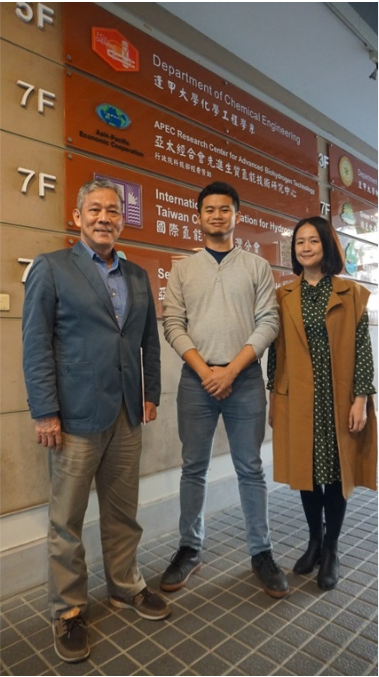
Picture 2: Professor Wu (left) and Project Manager Michael CH Liu (center) and Project Manager Chui Hui-chen (right) (Photo taken by Pei-lin Lin)
ACABT Takes Root in South East Asia while Moving into the US and Australia
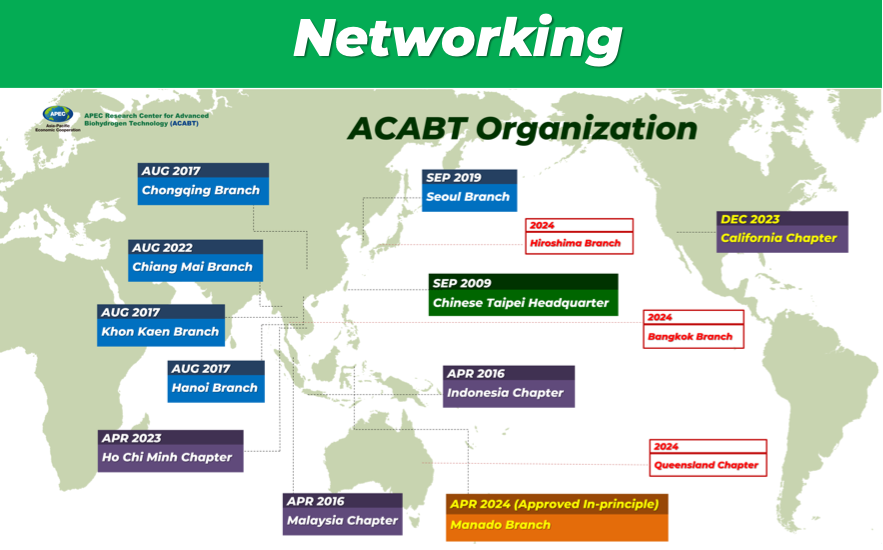
Picture 3: ACABT overseas branch organization list (Courtesy of Professor Wu)
To break down the remarkable ACABT overseas branch organization list, its headquarters was established in 2009 at Feng Chia University. However, Professor Wu served as the director of the NSTC Science and Technology Division
Taipei Representative Office in Moscow from 2012 to 2014. Therefore, efforts to establish the center's regulations and organizational charter only began in 2015. Subsequently, branches were established, starting with Malaysia and Indonesia in 2016, followed by branches in Chongqing, China, and Thailand in 2017. In 2019, a branch was established in Seoul. After 2020, Chiang Mai and Ho Chi Minh City became homes to their branches. Last year, the organization expanded its presence to California, and three more branches are set to be established in 2024.
It’s no wonder that Professor Wu’s famous saying “Join us to join the world" rings so true. However, I still wondered what kind of energy could gather so many countries to become branches of this center. The answer dates back to 18 years ago. Way back in 2006, Professor Wu attended a meeting in Lyon where Europe already placed significant emphasis on biohydrogen energy. Moreover, Professor Wu made connections with numerous teams in Europe and the United States that were working on biohydrogen energy. Thus, Professor Wu established Asia BioHyLinks ABHL) after returning to Taiwan. Over the years, Professor Wu has developed biohydrogen technology to convert biomass waste and wastewater into energy, materials, and eco-friendly chemicals. Thus, the UKM-YSD Chair for Sustainability, a foundation in Malaysia, invited Professor Wu's team to teach them how to convert palm oil wastewater into hydrogen methane. Professor Wu was even able to establish connections in the US because the University of California, Riverside, a renowned agricultural institution and long-standing collaborative partner of Mexico and Chile, established a branch in 2023 after recognizing the core values of ACABT. In the near future, both sides of the Pacific Ocean will be linked after establishing a branch in Hiroshima, Japan and Bangkok, Thailand.
From Slaughterhouses to Power Plants – Cow Dung and Fruit Peels Help Turn Medan, Indonesia into a Bioenergy Pioneer
Before the establishment of the Indonesian branch in 2016, the Vice-Governor of West Sulawesi, Indonesia earnestly sought the help of Professor Wu and Professor Chen-Yeon Chu after hearing their presentations at an international conference. The Vice-Governor hoped to use bioenergy technology to find solutions to help Indonesian climate refugees who were forced to relocate to highland areas without water and electricity due to flooding and wind disasters.
Starting in 2011, Professor Wu and the Vice-Governor began discussing a partnership. In 2014, they moved a shipping container to Medan, Indonesia and produced biogas in it by fermenting cow dung from slaughterhouses and banana leaves and coconut shells from the local fruit and vegetable market. The partnership used this to establish a small-scale bioenergy power plant in the area, which has served as the power system in permanent housing for climate change refugees. This successful case was applied in 39 other regions after becoming an educational training demonstration area for Indonesia. The entire process was documented in the film Brown Is the New Green, which was jointly produced by the Ministry of Science and Technology (now the NSTC) and National Geographic. Watching biogas power illuminate a local church was one of the documentary’s most inspiring moments. What's even better is that in addition to generating electricity, due to its organic properties, locals can now use biogas slurry as an organic fertilizer to grow chilli peppers and fruit trees.
Indonesia also has many students pursuing master's and doctoral degrees in bioenergy technology at Feng Chia University. Moreover, it is expected that the bioenergy power plant in Medan will be upgraded to its second generation by 2024 thanks to Professor Wu’s international cooperation under the University Social Responsibility program.
Changing Perspectives for a Sustainable Future
Professor Wu then pointed out that the most urgent thing the world needs to enhance is its mindset. He followed this statement by telling me a story while showing me some slides. While in lockdown during the pandemic in 2020, Professor Wu began contemplating how to achieve net zero emissions by 2050. It took him a whole three months to formulate what he humorously calls his "Thangka Map" solution. This solution even caught the attention of the Dean of the Business School, in the Faculty of Business, Economics and Law at the University of Queensland, Australia, who was greatly impressed and hoped to utilize the results of Professor Wu's painstaking efforts. Subsequently, Professor Wu generously agreed to share his work.
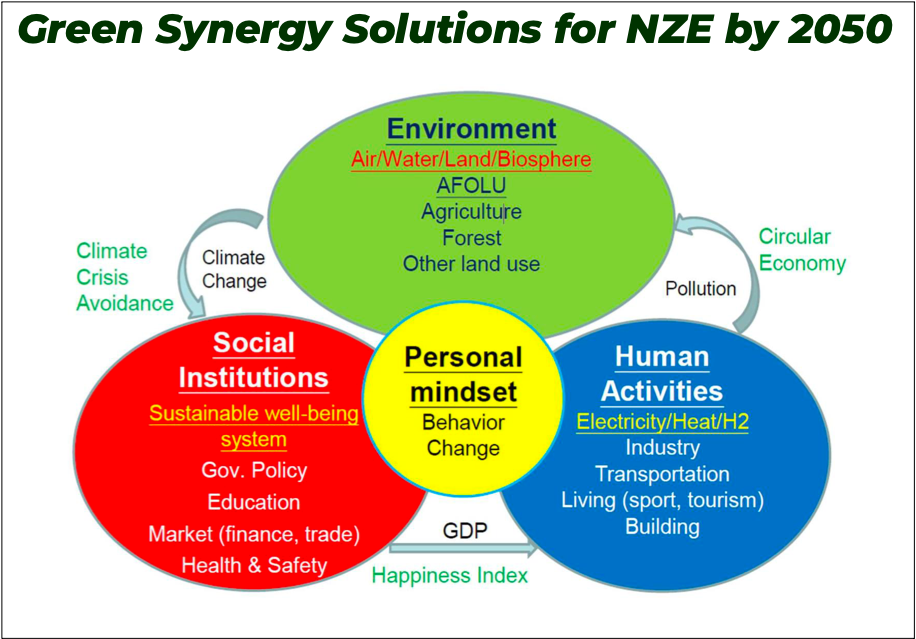
The "Sustainability Thangka"- A solution for circular energy sustainability (Illustrated by Professor Wu)
Just as the academic community should engage in transnational and interdisciplinary collaboration, the renewable energy sector should also once again aspire to its most essential core values. Starting with “changing mindsets” and “changing habits,” the sector must get rid of the tendency for wind, solar, and bioenergy to operate in isolation. Instead, it should consider joining forces to take climate change head-on.
When it comes to mindset and habits, Professor Wu mentioned that low-carbon initiatives are not just slogans anymore. Nowadays, their impact on the environment is substantial and is crucial for the survival of a business. Professor Wu also brought up his work about teaching a denim manufacturer in Miaoli about carbon reduction. The company expressed that this has become a priority because upstream supply chains explicitly state that they prefer partnering with low-carbon manufacturers. Hypothetically, a product sold to Europe nets NT$100 and makes a profit of NT$20. However, profits are significantly reduced if carbon taxes take away NT$10. But, if the supply chain is carbon neutral, the profit margin would remain at twenty percent when entering Europe. Thus, it’s clear that in the long run, only suppliers capable of meeting or approaching net-zero carbon emissions will survive.
Starting from the Ground Up – Professor Wu Creates an International Competition for Student Entrepreneurship
Since changing mindsets started with education, Professor Wu also established an O2O (online & offline) education platform at Feng Chia University, which has attracted students from across the Asia-Pacific region. This platform gives students the chance to attend classes online and participate in presentations and competitions in person. Starting in 2017, in collaboration with the Ministry of Science and Technology (now the NSTC), Professor Wu proposed organizing the “APEC YES Challenge,” a planning and solution challenge for youth entrepreneurship.
Professor Wu chuckled as he recounted how in previous years, the most challenging part was raising funds for the competition’s prize money. However, the competition has since grown in popularity. Now, when overseas branch offices announce information about the competition, students and researchers from countries such as Vietnam, Indonesia, Thailand, and Malaysia all clamor to get a spot. Each year, a different theme focuses on promoting sustainable development by applying green energy to solve environmental and social issues. Over the years, student teams have demonstrated remarkable creativity. For example, there were 162 participants on 31 teams from six APEC economies (Taiwan, Indonesia, Malaysia, the Philippines, Vietnam, and mainland China) that participated in 2023. The host team from Feng Chia University won the competition for Taiwan by providing the necessary electricity for daily farm operations through biogas power systems that converted agricultural waste into clean and renewable energy.
What’s even more remarkable is the process itself. In addition to every team presenting their sustainability solutions, the students get more excited about the possibility of reshuffling teams, forming international partnerships that span across different disciplines, and working together to prepare materials and deliver presentations onstage.
Looking back over Professor Wu’s career, it seems like he would be extremely exhausted after spending 18 years with the Feng Chia Hydrogen Energy team to create a biohydrogen energy system, organizing 18 consecutive international conferences, networking with international experts from public, private, academic, and research sectors around the world, and planning to continue organizing cross-border youth entrepreneurship planning competitions.
In response, Professor Wu said, “Letting people know what Taiwan is made of gives me a deep sense of purpose”.
Thanks to these competitions, partnerships, and educational initiatives, these students and researchers will naturally have a better opinion regarding Taiwan once they start making high-level decisions for their respective governments five or ten years down the line. Similarly, if they enter the private sector, their recognition of local companies will drive demand throughout Taiwan’s supply chain. However, Professor Wu hopes for more than just Taiwan’s benefit. He also knows that change begins from the heart. Thus, he hopes that everyone can help promote his "Sustainable Thangka" and turn green values into more than just slogans.
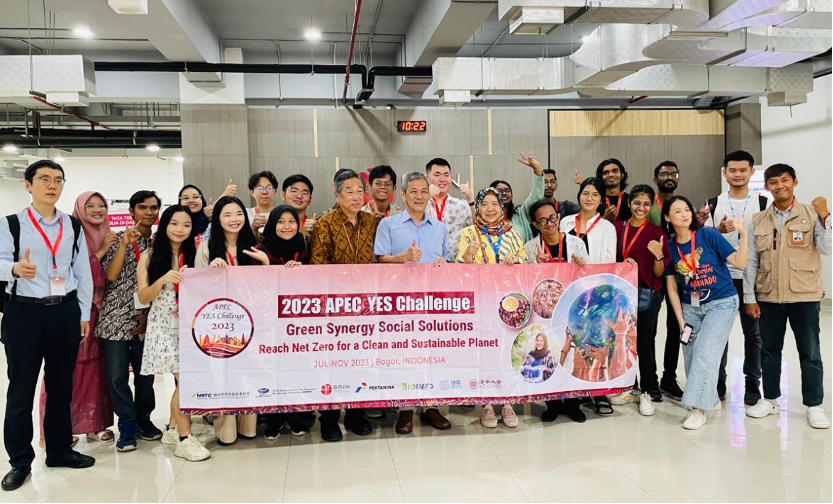
Picture 5: 2023 APEC YES Challenge technical visit - Group photo with members of a competition team at a BRIN genomics research facility (Courtesy of Professor Wu)
Columnist
.png) Pei-lin Lin
Pei-lin Lin
Pei-lin Lin obtained her B.A. in Philosophy from Fu Jen University and her M.A in Political Science from National Taiwan University. Lin embodies a humanistic literacy and political sensibility. In recent years, Lin has collaborated with the Taiwanese government to shoot videos promoting various policies. Currently, Lin splits her time between running a Chan Lands Ltd., Zongdipan, making documentary films and hosting the podcast “Human Translation Machine.” In the past, Lin has been a reporter for several media outlets and the anchor of shows on TVBS, CBC and Da Ai Television. While at Da Ai Television, Lin’s piece “Muhammad Yunus- Savior of the Poor,” was nominated at the First Taiwan Golden Wheel Awards for Outstanding Television News Feature.